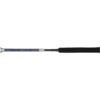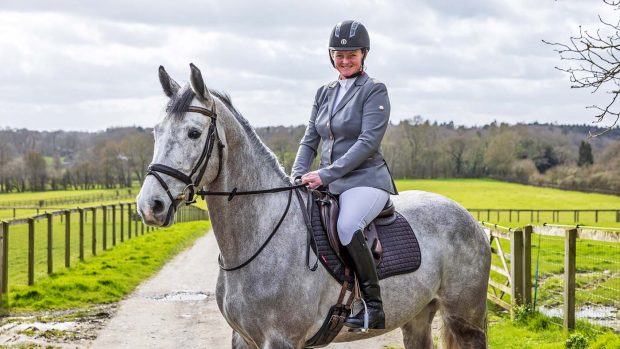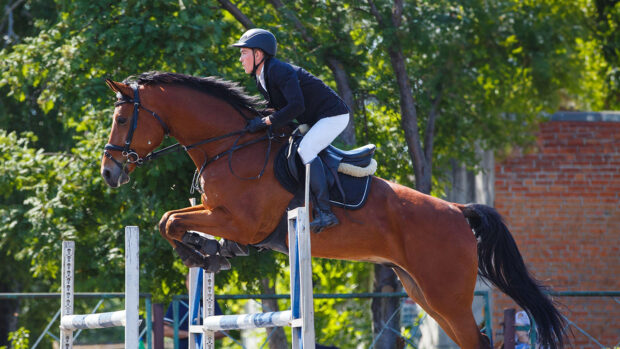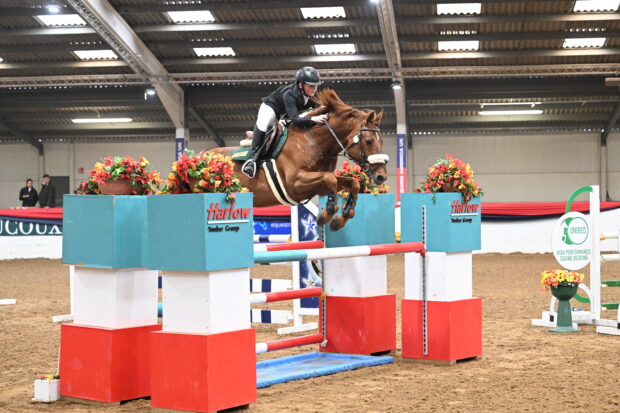Whether you’re thinking about entering your first showjumping event or you’ve just affiliated with British Showjumping, one of your first questions will be what to wear. There are strict rules on dress code in affiliated competitions, but for unaffiliated shows, the guidelines tend to be less stringent.
You can skip down to read about what to wear at affiliated showjumping events.
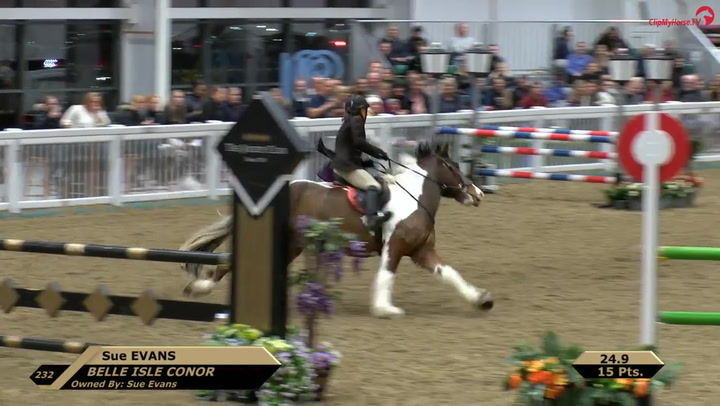 Watch the video
Watch the videoWhat to wear for showjumping
Compared to dress codes for eventing and what you should wear for dressage, the guidelines for showjumping are simpler as there’s no difference between the levels. In short, you’ll need the following items, but we’ve got lots more information on the specific rules below:
- riding hat – this must comply with the correct safety standards. (See our guide to the best riding hats)
- riding boots – long boots, in black, brown or navy, or short boots in the same colours with matching leather gaiters. (See our guides to the best long boots and best jodhpur boots)
- breeches – must be white, pale yellow, beige, grey, fawn, navy or black in colour. (See our guide to the best competition breeches)
- show jacket – both traditional-style tailored jackets and new-styled jackets are permitted. (See our guides to the best show jackets and best tweed jackets)
- show shirt – long- or short-sleeved with a white collar. (See our guide to the best show shirts)
- stock or tie – if you don’t have a high white collar, you’ll need to wear either a stock or tie (stocks are more common and tradition suggests to wear a white stock with black/navy jacket but coloured with tweed)
- gloves – optional. (See our guide to the best riding gloves)
Other important tips
- Long hair should be tidy and secured appropriately
- Competitors are advised to remove jewellery
What to wear at an unaffiliated showjumping competition
You won’t go wrong if you adhere to the affiliated rulebook, as described below. However, the dress code tends to be more lenient at local unaffiliated shows. For example, adults will often be permitted to wear jodhpur boots with half chaps rather than a traditional long riding boot.
Whatever the level of show, you’ll want to be smartly turned out in jacket, light-coloured jodhpurs/breeches and stock or tie if you don’t have a shirt with a high white collar. If you want to wear something different, contact the show secretary to check that it is permitted.
One item which is essential whatever the code, is protective headgear to the appropriate safety standard:
- British: All PAS (2011), VG1 – provided they are BSI Kitemarked.
- European: VG1 – provided they are BSI Kitemarked.
- American: all SEI ASTM F1163 04a onwards and SNELL E2016.
- Australian and New Zealand: AS/NZS 3838 2006 onwards.
What to wear for affiliated showjumping competitions
Competitors must be dressed in correct riding clothes, including jackets, whenever they enter the arena.
Jackets
- Competitors may wear traditional-style tailored jackets, including hacking jackets, or new-styled jackets, with the exception of British team colours (dark blue with red collar and white piping, Union Flag on the breast pocket area).
- New style jackets are subject to various regulations:
- – they must be fully zipped up in competition.
- – up to three sponsor logos can appear on the right sleeve, all three contained within 6x14cm, and one logo on the breast pocket (3x4cm)
- – riders’ names may appear on the back of the jacket in upper and lower case letters, using the type face Cosmos Light or Arial, with letters 4cm in height.
- Members of the armed forces or police force may wear their uniforms.
- In hot weather, riders may be allowed to compete without jackets at the judges’ discretion, wearing shirts with either long or short sleeves, and ties firmly secured.
Shirts
- May have short or long sleeves, and must be done up properly
- Shirts must have white collars, and long sleeves must have white cuffs
- To be worn with ties or hunting stocks
- Ladies may wear shirts with high white collars, and without a tie or stock
- Coloured ties or stocks may be worn with hacking jackets
- Junior members who are also Pony Club members may wear the Pony Club tie regardless of jacket colour
Breeches/jodhpurs
- Must be white, pale yellow, beige, grey, fawn, navy or black in colour
Boots
- Traditional style riding boots, either long or short, but short boots must be worn with leather gaiters.
- Permitted colours are:
- – Plain black, or black with mahogany or patent tops.
- – Plain brown, or brown with patent tops.
- – Plain navy, or navy with mahogany or patent tops.
- For juniors, traditional style leather jodhpur boots in plain black, brown or navy may be worn with leather gaiters cut in the traditional riding boot style, or half chaps.
Gloves
- Optional
Body protectors
- Optional, with no specific standard required
- Air jackets can be worn without a body protector
Not permitted
- Polo necks
- Chaps
- Half chaps, except for junior riders (as detailed above).
- Video recording or camera equipment is not permitted to be worn anywhere on the horse/pony or rider when mounted anywhere on the showground.
Hats
- Protective headgear must be worn at all times when riding, with the harness securely fastened.
- Hats must meet one of the following standards:
- – British: All PAS 015 (2011), VG1 – provided they are BSI Kitemarked.
- – European: VG1 – provided they are BSI Kitemarked.
- – American: all SEI ASTM F1163 2004a onwards and SNELL E2016.
- – Australian and New Zealand: AS/NZS 3838 2006 onwards.
Spurs
- No spurs of excessively severe design
- Only dummy, rollerball, impulse, rowelled, hammerhead or Prince of Wales spurs are permitted
- Rowelled spurs if worn, must have smooth rowels, with a diameter of no less than 1cm and no greater than 2cm, with a minimum width of 1.8mm. The rowels must sit in the vertical plane; horizontal rowels are not allowed. Rowels are not permitted for ponies
- No spurs with interchangeable/removable shanks
- No spurs necks set on the inside of the heel
- No spurs with roughened or cutting edges
- No serrated spurs
- Overall length of spur should not exceed 4cm (measured from back of boot to end of spur). For ponies, this should not exceed 2.5cm
- Spurs should be of smooth material (metal or plastic)
- Shank must be blunt and point only towards the rear
- Only one pair of spurs should be worn, traditionally fitted with the curve of the neck of the spur pointing downwards
- For pony classes, spurs with necks must not exceed 2cms long, and they are not to be pointed, sharp or rowelled
Whips/padded batons
In December 2024, Horse & Hound reported changes to the use of padded batons, which replaced whips in British Showjumping competitions five years ago. You can read about the new British showjumping whip rules, which came into force on 1 January 2025, here.
In affiliated showjumping, competitors at all levels may carry a padded baton:
- Between 45cm and 70cm in length with a shaft of minimum 1cm diameter and not exceeding 160g
- That has a contact area (the part of the padded baton that will or has the potential to contact the horse) two fifths of the padded baton’s overall length
- With a pad covering the contact area that is smooth, with no protrusion or raised surface, wording, advertising or personalisation. The pad must be made from shock-absorbing material that gives a compression factor of at least 6mm and there must be no binding within 17cm of the end of the pad
- To stay up to date with all the breaking news from major shows throughout 2025, subscribe to the Horse & Hound website
You may also be interested in:

16 of the best competition breeches to wear in the saddle this season

14 of the best long leather riding boots for every budget

Dress for success with Horse & Hound’s what to wear guide for dressage competitions

Gearing up for the eventing season? Check out what you need to wear…
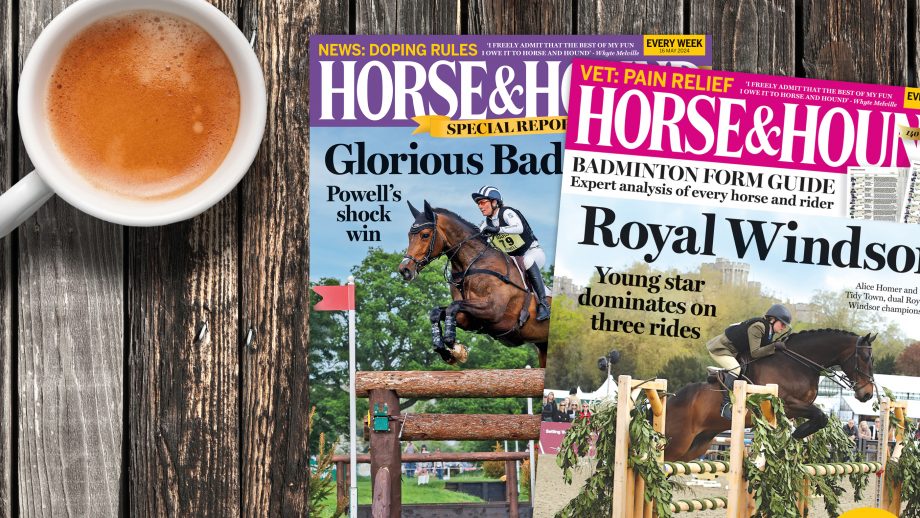
Subscribe to Horse & Hound magazine today – and enjoy unlimited website access all year round


